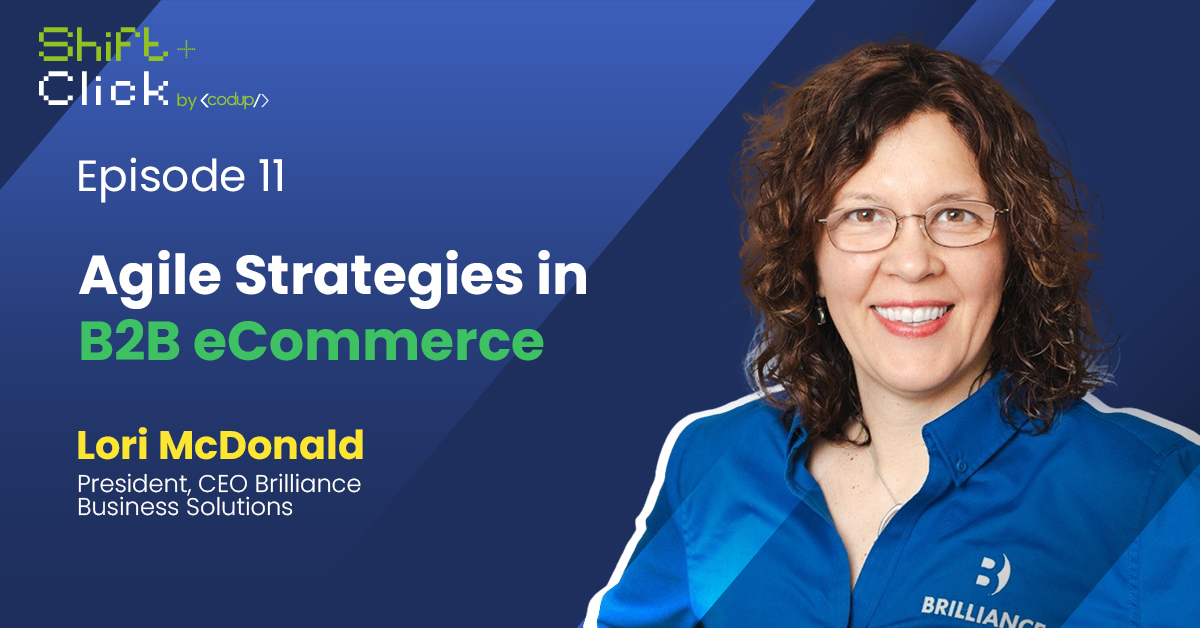Agile Strategies in B2B eCommerce [Podcast Insights]

From Nasa Space Center to pioneering digital B2B solutions, Lori McDonald (Our podcast’s guest) represents a journey of innovation and exploration in the world of B2B Commerce on our 11th episode of Shift Click podcast. The woman who always pushed the boundaries of what’s possible and showed that innovation isn’t confined to one domain but can be applied across various industries and sectors, including the digital space where she now operates.
Driving innovation and progress in new and unexpected ways, Lori McDonald sheds light on how vital change adoption is in the evolution of B2B eCommerce, finding sustainable solutions and bridging the gap by educating business owners on tech decisions. At the end, she shared her invaluable insights on how to avoid technical debt and build a sustainable digital infrastructure.
You can listen to the full podcast by clicking on the play button below:
The Dynamic Shifts And Advancements In B2B Digital Commerce
As this digitally native generation further gains decision-making power, their online shopping experiences are profoundly influencing their expectations of B2B transactions.
B2B buyers are increasingly expecting B2C-like experiences in their purchasing journey. A survey by Salesforce found that 76% of B2B buyers expect companies to understand their needs and expectations, similar to how B2C companies do.
The evolution of B2B e-commerce over the past two decades highlights significant shifts and advancements in the industry.
It is important to realize the changes in the ever-evolving digital landscape as it is essential to adapt to the new reality. Understanding how customer expectations are transforming is of utmost importance.
In the past, digital channels for B2B commerce were mostly suitable for straightforward, modest transactions within set limits.
However, this perception has changed significantly. Currently, 70% of B2B buyers are willing to engage in digital, remote, or self-service transactions that exceed $50,000.
Moreover, more than a quarter (27%) are open to transactions that surpass the $500,000 mark.
The takeaway for B2B organizations is that there is greater scope than ever for online and remote sales if they can get the digital experience right.
Sustainable Practices in B2B E-commerce
Sustainability is becoming a more significant initiative for many businesses. This is sometimes motivated by a genuine concern by business stakeholders to operate more sustainably and ethically.
Lori McDonald shared her insights on building a sustainable business model and how consumers demand sustainable commerce.
Her observations likely address the evolving expectations of consumers increasingly prioritizing sustainability when engaging with businesses. This indicates a shift in consumer behavior towards favoring companies committed to sustainability, prompting B2B enterprises to adapt their practices to meet these demands and ensure long-term success.
“ It’s not simply a fad in B2B e-commerce; it’s essential to success. Customers want ethical and friendly practices in addition to goods. We must embrace sustainable business strategies and give priority to individualized experiences across all channels as we navigate this context. Our success is defined by our path towards sustainability rather than just the final product. ”
Lori McDonald
Take Tech Decisions Carefully and Thoughtfully
With the ever-growing reliance on technology, entrepreneurs need more than just a groundbreaking idea to succeed; they need tech education.
This gives you the ability to make decisions that are in the best interest of your business, which will help it grow faster than if you were making uninformed decisions based on what others told or taught you or, even worse, guessing at what decision would help grow your company.
Lori McDonld highlights the value of consulting with industry experts, attending conferences, and conducting research to make well-informed decisions.
“You know, seeking a second opinion is always a good idea. If the agency you’re already working with suggests a course of action, it might also be worth talking to a few other experts. Ask them about scalability or the long-term costs of maintaining these customizations in the future. It’s important for everyone to pause and think before making decisions. So, always consider getting a second opinion or consulting with the right people to determine what’s best for your situation.”
Lori McDonald
It presents the importance of viewing tech decisions as part of a continuous learning journey, where businesses prioritize adaptability, innovation, and customer-centricity.
Mitigating Technical Debt And Ensuring Long-Term Viability In B2B
Businesses often find themselves in a race to adopt the latest trends and tools to stay competitive.
However, this rush to innovate can sometimes lead to the accumulation of technical debt, the shortcuts taken, or outdated technologies used in the development process that can result in higher costs and slower progress in the long run. Building a sustainable digital infrastructure involves carefully managing these risks to ensure that your technology investments continue to support your business goals efficiently and effectively over time.
To address these challenges, Lori McDonald says businesses must adopt a proactive approach to managing their digital infrastructure. This involves thorough planning, continuous monitoring, and regular evaluations to identify potential areas of improvement and mitigate risks. By prioritizing scalability, flexibility, and innovation while also considering factors such as technical debt, legacy system integration, and security, organizations can build a sustainable digital infrastructure that supports their long-term growth and success.
Avoiding technical debt and building a sustainable digital infrastructure requires a strategic and holistic approach that considers both short-term goals and long-term objectives.
By investing in the right technologies, processes, and expertise, businesses can future-proof their digital infrastructure and position themselves for continued innovation and growth in an ever-changing digital landscape.
At Codup, we specialize in B2B eCommerce development, assisting enterprise companies in meeting the increasing demands of the digital market.
Our B2B commerce solutions cater to manufacturers, distributors, and wholesalers of all sizes. We focus on improving business efficiencies and delivering self-service, frictionless experiences to B2B buyers. With our expertise, you can navigate the complexities of digital transformation, ensuring scalability, security, and innovation without accruing technical debt.
Get the Right People on the Bus
It’s crucial to ensure that your team is not only capable of adapting to the ever changing digital landscape but also possesses diverse skill sets and perspectives. Accepting diversity on your staff encourages resilience, creativity, and inventiveness, all of which can help your company succeed in the fast-paced market of today. Furthermore, fostering a culture of continuous learning and development among your team members ensures that they remain equipped with the latest knowledge and expertise to tackle emerging challenges and seize new opportunities. Remember, the success of your digital journey hinges not only on the technology you implement but also on the people who drive its execution.
“My final advice to everyone is to see their digital journey as a continuous process. Make sure you have a team that can grow with your business. By doing this, you’ll find success and improvement. They’ll find success, and hopefully, that’s something that’ll help them build a 25-year-old business that’s still going.”
Lori McDonald
Conclusion
The evolution of B2B e-commerce is marked by the merging of sustainability, customer–centricity, technological innovation, and ethical considerations. In order to succeed in this changing game, businesses must put sustainability first, provide exceptional customer experiences, use technology effectively, and align their strategies with changing consumer preferences.
By doing so, B2B enterprises can set themselves up for long-term success in the dynamic commerce environment.



